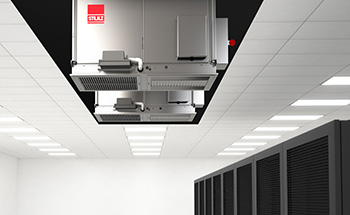Computer Room Air Conditioner Units

When it comes to the protection of computer equipment, heat and humidity levels are of foremost concern. Electronic equipment generates a significant amount of heat, so it is imperative that the environment in which it is housed be kept cool enough to keep computer systems from overheating.
Similarly, a regulated level of humidity is essential in maintaining and protecting computers and data systems. A low humidity environment can lead to static build up and damaging static electric discharge. Excessive humidity can lead to condensation and the development of moisture, creating the risk of corrosion.
CRAC vs. Comfort Cooling Systems
Unlike cooling systems that are designed to keep spaces comfortable, CRAC units are engineered for the needs of sensitive equipment. Computer room air conditioners run 24/7, while comfort cooling systems operate periodically by design, for efficiency and to avoid system strain.
Another characteristic that distinguishes CRAC units from air conditioning units for comfort cooling is filtration. Comfort cooling systems typically rely on pleated media filters. In computer room air conditioning applications, high performance air filters, such as HEPA filters are used to capture extremely small airborne particulate, which may be damaging to computer equipment.

CRAC System Components
Computer room air conditioning systems are typically comprised of three main components:
Air Filters
The air filters used in CRAC systems are High Efficiency Particulate Air (HEPA) filters. HEPA filters are designed to remove at least 99.97% of dust, pollen, mold, bacteria, and any airborne particles with a size of 0.3 microns (µm). Extreme filtration in CRAC units helps to assure that computer equipment is protected from contamination.
Cooling Coils
Cooling coils in CRAC units allow the system to cool and dehumidify the air. The types of coils used in a CRAC system include: direct expansion, chilled water, or dual type.
The cooling coils in a direct expansion type CRAC is also referred to as an evaporator. The cooling coil in this type of system relies on refrigerant. A chilled water type CRAC has a cooling coil connected to a chiller system that provides cold water flow. A dual CRAC system has both chilled water and direction expansion cooling coils. One type of coil works while the other is on standby, or the cooling coils operate simultaneously to provide cooling.
EC Fans
The EC fans used in CRAC systems are different from the belt-driven blowers and induction motors used in comfort cooling air conditioning units. Belt-driven blowers need replacement and maintenance due to wearing parts. EC fans are a great alternative, taking up less space making installation less complicated. They are quiet in operation, efficient, produce less heat, cost less to run, and have a longer lifespan.
Humidifiers & Dehumidifiers
Since humidity level is so critical in computer rooms and data centers, humidifiers and dehumidifiers can be installed in CRAC systems. Humidifiers increase the amount of moisture in the air to reduce the risk of static electricity. Dehumidifiers in CRAC systems control the amount of water vapor in the air to decrease the chance of corrosion. Electric heaters near the cooling coils to increase air temperature and desiccant dehumidifiers can be used to efficiently decrease humidity.
Need a CRAC solution from STULZ for your data center? Level Solutions has the experience and expertise to help you find the right system to meet your needs. Contact us to discuss your needs.
